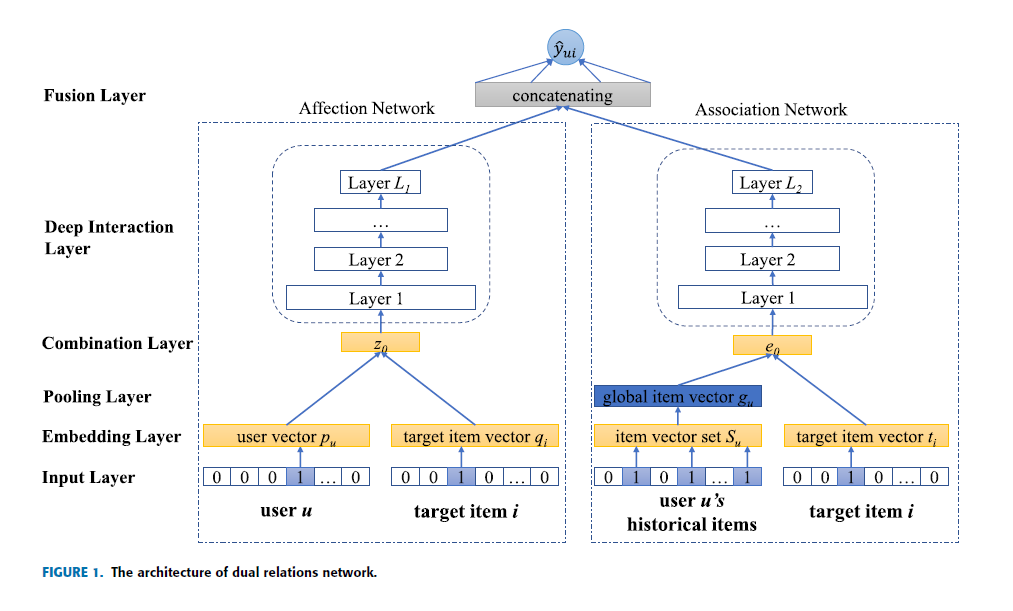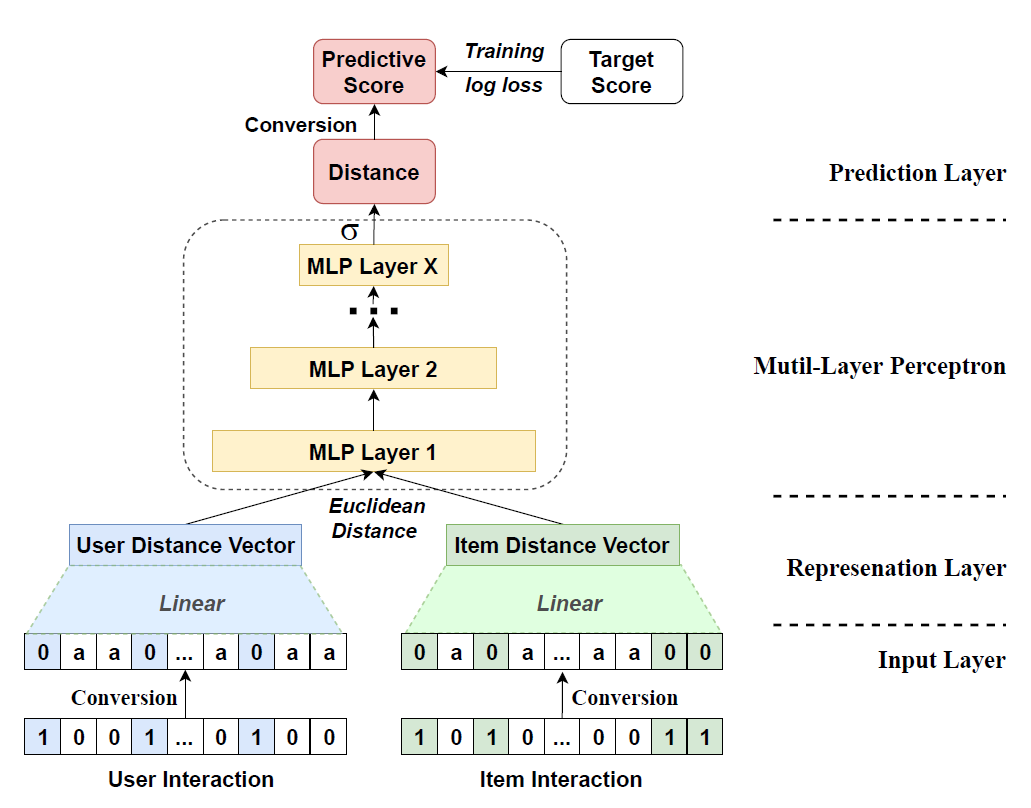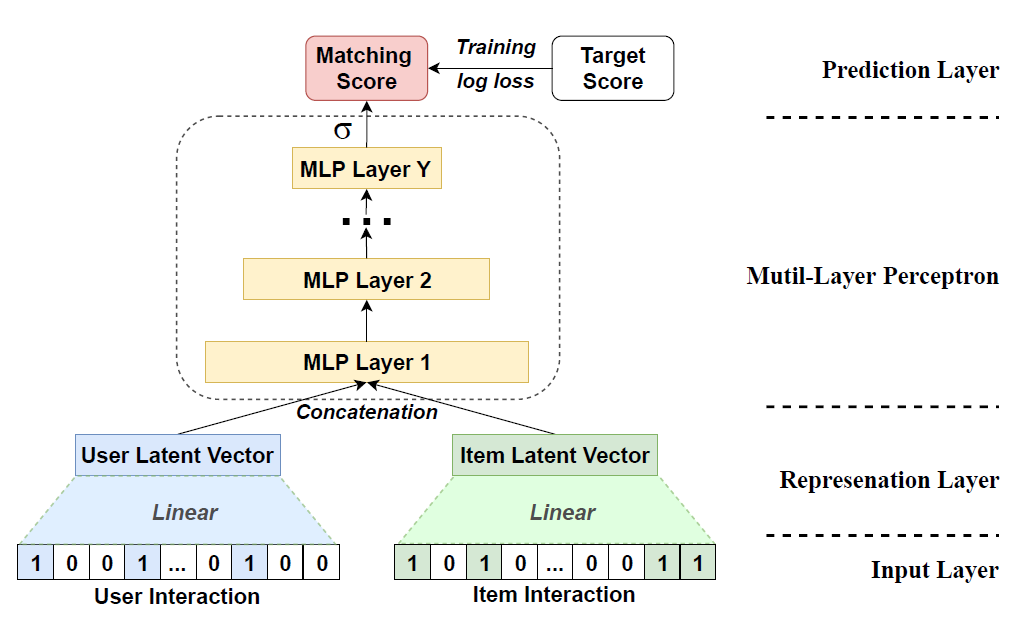Distance Embedding based Latent Factor Model
Based on the following lectures
(1) “Recommendation System Design (2024-1)” by Prof. Ha Myung Park, Dept. of Artificial Intelligence. College of SW, Kookmin Univ.
(2) "Recommender System (2024-2)" by Prof. Hyun Sil Moon, Dept. of Data Science, The Grad. School, Kookmin Univ.
Learning Objectives
- 표현 학습(Representation Learning)
- 사용자와 아이템을 공동의 잠재요인 공간에 표현하는 방법
- 매칭 강도 추정 시 내적(Inner Product) 등 선형 유사도 함수를 적용함
- 저차원(Low-rank) 유사도 구조를 효율적으로 포착할 수 있음
- 매칭 함수 학습(Matching Function Learning)
- 사용자-아이템 쌍을 입력으로 하여 매칭 함수를 직접 학습하는 방법
- 복잡하고 비선형적인 매칭 함수를 근사할 수 있음
DDFL
-
문제 의식: 내적(Dot Product) 혹은 코사인 유사도(Cosine Similarity)를 매칭 함수로 사용하여 학습된 사용자, 아이템 표현은 삼각 부등식(Triangular Inequality)을 만족하기 어려움
- 삼각 부등식(Triangular Inequality)
-
세 점 사이의 거리에 대한 제한 조건으로서, $A$ 와 $C$ 사이 거리는 $A$ 에서 $B$, 그리고 $B$ 에서 $C$ 로 우회하는 거리보다 크거나 같아야 함
\[\begin{aligned} \text{d}\left[A,C\right] \le \text{d}\left[A,B\right] + \text{d}\left[B,C\right] \end{aligned}\] -
사용자 $u$ 가 아이템 $i$ 를 직접적으로 선호하는 정도는, 사용자 $u$ 가 아이템 $j$ 를 선호하는 정도 및 아이템 $i$ 와 $j$ 간 유사한 정도의 합보다 작거나 같아야 함
\[\begin{aligned} \overrightarrow{\mathbf{p}}_{u} \cdot \overrightarrow{\mathbf{q}}_{i} \le \overrightarrow{\mathbf{p}}_{u} \cdot \overrightarrow{\mathbf{q}}_{j} + \overrightarrow{\mathbf{q}}_{i} \cdot \overrightarrow{\mathbf{q}}_{j} \end{aligned}\]
-
DDFL(DeepDualFunctionLearning-based Model) : 거리 함수 학습 모듈과 매칭 함수 학습 모듈을 병렬 학습하는 앙상블 모형- Shah, S. T. U., Li, J., Guo, Z., Li, G., & Zhou, Q.
(2020, September).
DDFL: a deep dual function learning-based model for recommender systems.
In International Conference on Database Systems for Advanced Applications (pp. 590-606).
Cham: Springer International Publishing.
- Shah, S. T. U., Li, J., Guo, Z., Li, G., & Zhou, Q.
- Components
MeFL:MetricFunctionLearningMaFL:MatchingFunctionLearningDDFL:MeFL&MaFLEnsemble
Notation
- $u=1,2,\cdots,M$: user idx
- $i=1,2,\cdots,N$: item idx
- $\mathbf{Y} \in \mathbb{R}^{M \times N}$: user-item interaction matrix
- $\overrightarrow{\mathbf{p}}_{u} \in \mathbb{R}^{K}$: user latent factor vector @
MeFL - $\overrightarrow{\mathbf{q}}_{i} \in \mathbb{R}^{K}$: item latent factor vector @
MeFL - $\overrightarrow{\mathbf{u}}_{u} \in \mathbb{R}^{K}$: user latent factor vector @
MaFL - $\overrightarrow{\mathbf{v}}_{i} \in \mathbb{R}^{K}$: item latent factor vector @
MaFL - $\overrightarrow{\mathbf{z}}_{u,i}$: predictive vector of user $u$ and item $i$
- $\hat{y}_{u,i}$: interaction probability of user $u$ and item $i$
How to Modeling
-
DDFLisMeFL&MaFLEnsemble:-
predictive vector of user $u$ and item $i$:
\[\begin{aligned} \overrightarrow{\mathbf{z}}_{u,i} &= \text{MLP}_{\text{ReLU}}(\overrightarrow{\mathbf{z}}_{u,i}^{\text{(MeFL)}} \oplus \overrightarrow{\mathbf{z}}_{u,i}^{\text{(MaFL)}}) \end{aligned}\] -
final matching score of user $u$ and item $i$:
\[\begin{aligned} \hat{y}_{u,i} &= \sigma(\overrightarrow{\mathbf{w}} \cdot \overrightarrow{\mathbf{z}}_{u,i}) \end{aligned}\]
-
MeFL
-
Conversion Transformation:
\[\begin{aligned} x_{u,i} &=\alpha\left(1-y_{u,i}\right) \end{aligned}\]- $y_{u,i} \in \mathbf{Y}$ is Implicit Feedback
- $\alpha$ is Distance Factor
-
History Embedding:
\[\begin{aligned} \overrightarrow{\mathbf{p}}_{u} &= \mathbf{W} \cdot \mathbf{X}_{u*}\\ \overrightarrow{\mathbf{q}}_{i} &= \mathbf{W} \cdot \mathbf{X}_{*i} \end{aligned}\] -
Calculate Euclidean Distance:
\[\begin{aligned} \text{dist}[\overrightarrow{\mathbf{p}}_{u}, \overrightarrow{\mathbf{q}}_{i}] &= \Vert \overrightarrow{\mathbf{p}}_{u} - \overrightarrow{\mathbf{q}}_{i} \Vert_{2}\\ &= \sqrt{\sum_{k=1}^{K}{(p_{k}^{(u)} - q_{k}^{(i)})^{2}}} \end{aligned}\] -
predictive vector of user $u$ and item $i$:
\[\begin{aligned} \overrightarrow{\mathbf{z}}_{u,i} &= \text{MLP}_{\text{ReLU}}(\text{dist}[\overrightarrow{\mathbf{p}}_{u}, \overrightarrow{\mathbf{q}}_{i}]) \end{aligned}\] -
if use
MeFLas a single prediction module:-
compute distance:
\[\begin{aligned} \hat{d}_{u,i} &= \sigma(\overrightarrow{\mathbf{w}} \cdot \overrightarrow{\mathbf{z}}_{u,i}) \end{aligned}\] -
convert distance to matching score:
\[\begin{aligned} \hat{y}_{u,i} &= 1 - \frac{\hat{d}_{u,i}}{\alpha} \end{aligned}\]
-
MaFL
-
History Embedding:
\[\begin{aligned} \overrightarrow{\mathbf{u}}_{u} &= \mathbf{W} \cdot \mathbf{Y}_{u*}\\ \overrightarrow{\mathbf{v}}_{i} &= \mathbf{W} \cdot \mathbf{Y}_{*i} \end{aligned}\] -
predictive vector of user $u$ and item $i$:
\[\begin{aligned} \overrightarrow{\mathbf{z}}_{u,i} &= \text{MLP}_{\text{ReLU}}(\overrightarrow{\mathbf{u}}_{u} \oplus \overrightarrow{\mathbf{v}}_{i}) \end{aligned}\] -
if use
\[\begin{aligned} \hat{y}_{u,i} &= \sigma(\overrightarrow{\mathbf{w}} \cdot \overrightarrow{\mathbf{z}}_{u,i}) \end{aligned}\]MaFLas a single prediction module:



